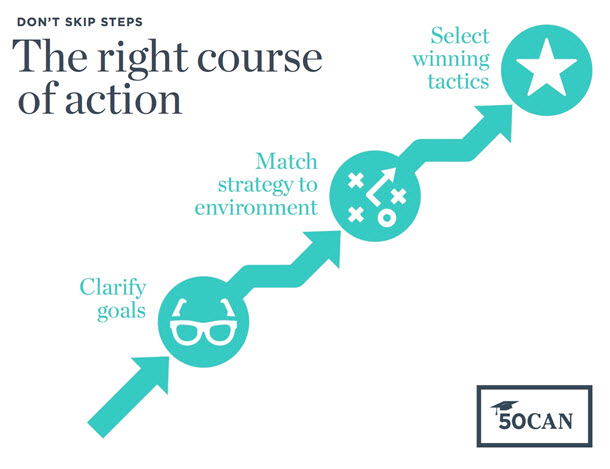Editor’s Note: While the Chalkboard does not publish advocacy on behalf of any specific policy agenda, it is an outlet for constructive conversations about the education world, including the work of advocates and their influence on policy.
“Because education in this country is by-and-large a public enterprise, champions of change and defenders of the status quo must turn to elected and appointed officials to advocate for their desired outcome,” write Russ Whitehurst, David Stuit, Claire Graves and Lauren Shaw in the recent Brookings Institution report Measuring and Understanding Education Advocacy.
The authors aim to answer the question “Do such advocacy efforts succeed in influencing the public policy that governs education?” The result is empirical confirmation for what those of us working in the field of education advocacy see every day: advocacy can shape the future of education in our states. But where do you start if you want to put advocacy to work on the education policies that matter to you and your community? That’s the question my colleagues and I at 50CAN: The 50CAN-State Campaign for Achievement Now have spent the past several years working to answer.
- dsdsdsdsd
- sdsdsdd
- sdsdsdsd
We got our start in 2005 as a small nonprofit in Connecticut (ConnCAN) working to shine a light on the state’s worst-in-the-nation achievement gap and build support for policy reforms that could make a difference for all kids. We hoped that other local advocates could benefit from what we learned on the ground and that we could, in turn, learn more from them. In January 2011, we launched the 50CAN network as a learning community where we are all sharing and growing together.
- sdsds
- sdsdsd
- sdsdsd
On November 12, we published the second edition of The 50CAN Guide to Building Advocacy Campaigns. This guide builds upon more than ten years of work in support of more than 100 of our policy campaigns to explain how we help local leaders develop policy goals, how we support them in crafting their advocacy plans, and how we work together to secure lasting changes. It is designed to help citizen advocates from all walks of life make their voices heard on the issues that are most important to them and their communities.
The guidebook emerged out of our multi-year investigation into the common characteristics of successful local advocacy campaigns, with success measured by the ability of advocates to achieve the stated goals of their campaigns. We examined these characteristics through a review of the campaign plans produced by our network of local advocates, interviews with participants, small group discussions and analysis of campaign metrics and policy outcomes.
In our research on the characteristics of effective educational advocacy campaigns, three lessons stood out:
Don’t skip steps
In our survey of over 100 campaigns the most important element of success boils down to one basic piece of advice: Don’t skip steps. Most successful advocacy campaigns we studied followed three key steps:
- Step 1: Clarify goals. There is nothing worse than “winning” in your advocacy campaign only to find out that the policies you helped enact actually do little to address the underlying problem you are so passionate about solving.
- Step 2: Match strategy to environment. One of the biggest challenges in this step is to weigh all the options carefully and select the strategy that best fits your goal, your strengths, and your environment.
- Step 3: Select winning tactics. There are hundreds of possible tactics that could be used in a campaign, so it’s critical that selecting winning tactics is always the last step in the advocacy campaign planning process. That way, you ensure the campaign is grounded in a specific strategy and used in the service of a specific goal.

Source: The 50CAN Guide to Building Advocacy Campaigns
Be strategic about your approach
The easiest mistake to make in advocacy is to move too quickly from the selection of goals to a discussion of tactics. This leads advocates to choose tactics without understanding how well they fit with a winning strategy or how effective they will be at reaching a specific goal. Skipping over strategy to talk tactics is like skipping the creation of blueprints and going straight to handing out tools to carpenters building a house. The successful campaigns that we studied often pursued one of four main strategic pathways:
- Option 1: Elite negotiation. In this strategy, advocates attempt to use their understanding of the interests of incumbent leaders to alter the status quo through trading and compromise. An example of one of the larger elite negotiations in recent years is the development and passage of the Affordable Care Act (or “Obamacare”).
- Option 2: Social movements. This strategy focuses on a large number of people getting organized over time to change the status quo in profound ways. This is the advocacy strategy that is often associated with major advancements in human rights. An example of a successful social movement in recent years is the push for marriage equality.
- Option 3: Expert communities. In this strategy, experts debate ideas over time and end up influencing policy, either through convergence or consensus. Perhaps the biggest policy debate being driven forward by the convergence of experts in our time is climate change.
- Option 4: Emergent networks. This strategy relies on change borne through trial and error, with good ideas being tested and refined by practitioners. The best of those ideas become common practices, and through dialogue with policymakers, they eventually become formalized into policies. An example of an emergent network from the field of education is the issue of blended learning.
The best way to never lose is to never give up
While it is common adage to say we learn more from failure than success, in our study of successful campaigns we found something a little different. Advocates learn the most when they overcome adversity by returning to their mistakes with new approaches until they find a path to success. Those paths to success then become roadmaps for future campaigns. More than anything else, it is their persistence, curiosity, and flexibility as they work towards securing a policy victory that makes the greatest difference.
But even when that major policy change is secured, the most successful advocates never say “mission accomplished.” There is always more work to do. A policy win is just the tip of the iceberg to ensure victories translate into life-changing experiences for kids.
With all the challenges of making change in the education world, it’s easy to get discouraged. It won’t always be on the timeline you would want or be the complete victory you are seeking, but if you are sensible in your approach and stick with the work, the ideas you are advocating for will have a chance to flourish, and in the end benefit students and schools.
For further reference, download The 50CAN Guide to Building Advocacy Campaigns as a PDF, Kindle e-book or Apple iBook to learn more about how you can become a better education advocate in your community. And follow 50CAN and Marc Porter Magee on Twitter at @FiftyCAN and @marcportermagee to join the conversation online.
The Brookings Institution is committed to quality, independence, and impact.
We are supported by a diverse array of funders. In line with our values and policies, each Brookings publication represents the sole views of its author(s).




